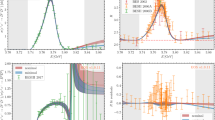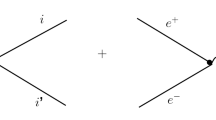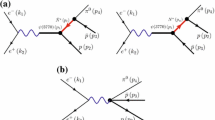Abstract
We analyze the cross section of \(e^+e^-\rightarrow \pi ^{+}\pi ^{-}J/\psi \) measured by Belle, BABAR and BESIII experiments. The parameters of the two resonances Y(4220) and Y(4360) are consistent with that in \(e^+e^-\rightarrow \pi ^{+}\pi ^{-}\psi (3686)\). A combined fit is performed to the two cross sections assuming the two resonances Y(4220) and Y(4360) have the same parameters. The parameters of Y(4220), Y(4360) and Y(4660) are determined to be \(M_{Y(4220)}=(4223.3\pm 1.6\pm 2.5)\) MeV/c\(^{2}\), \(\Gamma _{Y(4220)}=(54.2\pm 2.6\pm 1.0)\) MeV; \(M_{Y(4360)}=(4386.4\pm 2.1\pm 6.4)\) MeV/c\(^{2}\), \(\Gamma _{Y(4360)}=(96.0\pm 6.7\pm 2.7)\) MeV; \(M_{Y(4660)}=(4646.4\pm 9.7\pm 4.8)\) MeV/c\(^{2}\), \(\Gamma _{Y(4660)}=(103.5\pm 15.6\pm 4.0)\) MeV, where the first uncertainties are statistical and the second systematic. The ratios \(\frac{\mathcal {B}(Y(4220) \rightarrow \pi ^{+}\pi ^{-}\psi (3686))}{\mathcal {B}(Y(4220) \rightarrow \pi ^{+}\pi ^{-}J/\psi )}\) and \(\frac{\mathcal {B}(Y(4360) \rightarrow \pi ^{+}\pi ^{-}\psi (3686))}{\mathcal {B}(Y(4360) \rightarrow \pi ^{+}\pi ^{-}J/\psi )}\) are also obtained, which may help in understanding the nature of these structures.
Similar content being viewed by others
Avoid common mistakes on your manuscript.
In recent years, charmonium physics has gained renewed strong interest from both the theoretical and the experimental side, due to the observation of a dozen of charmonium-like states, such as X(3872) [1, 2], Y(4260) [3,4,5], Y(4360) [6, 7] and Y(4660) [7]. These states do not fit in the conventional charmonium spectroscopy, and they are good candidates for exotic states beyond the quark model [8]. Among them, the vector charmonium-like states, having quantum numbers \(J^{PC}=1^{--}\), are usually called Y-states. The first observed Y-state is Y(4260), which was seen by BABAR [3] in the \(\pi ^{+}\pi ^{-}J/\psi \) mass distribution through initial-state-radiation (ISR) process, then confirmed by CLEO [4] and Belle [5] experiments. With high statistic data, BESIII experiment observed the fine structure for Y(4260) in \(e^+e^-\rightarrow \pi ^{+}\pi ^{-}J/\psi \) [9]. The Y(4260) is a combination of two resonances, the lower one’s mass is around 4.22 GeV/\(c^2\) and the higher one’s mass is around 4.32 GeV/\(c^2\). The resonance Y(4220) also is observed in some other decay channels at BESIII, such as \(e^+e^-\rightarrow \omega \chi _{c0}\) [10, 11], \(\pi ^{+}\pi ^{-}h_{c}\) [12, 13] and \(\pi ^{+}D^{0}D^{*-}\) [14].
Another famous Y-state Y(4360) was firstly observed by BABAR [6] in \(\pi ^{+}\pi ^{-}\psi (3686)\) mass distribution, then confirmed by Belle [7] experiment. Belle also observed another structure, Y(4660), in the \(\pi ^{+}\pi ^{-}\psi (3686)\) [7]. Recently, using the results for \(e^+e^-\rightarrow \pi ^{+}\pi ^{-}\psi (3686)\) from Belle [15], BABAR [16] and BESIII [17] experiments, the authors of Ref. [18] observed the fine structure for Y(4360) in \(e^+e^-\rightarrow \pi ^{+}\pi ^{-}\psi (3686)\), inferring that also the Y(4360) is a combination of two resonances, the lower one’s mass is around 4.22 GeV/\(c^2\) and the higher is around 4.38 GeV/\(c^2\). There are many theoretical models to explain these Y-states, such as hybrid charmonium, tetraquark state and the molecular state [19]. However, there is still no definite conclusion. On the other hand, there are still missing excited charmonium states predicted by the potential models, which we have not observed. So it is important to confirm which Y-states are charmonium and which Y-states are exotic states. In this paper, we revisit the \(e^+e^-\rightarrow \pi ^{+}\pi ^{-}J/\psi \) and \(e^+e^-\rightarrow \pi ^{+}\pi ^{-}\psi (3686)\) line shape, and we perform a combined fit to the two cross sections \(e^+e^-\rightarrow \pi ^{+}\pi ^{-}J/\psi \) and \(e^+e^-\rightarrow \pi ^{+}\pi ^{-}\psi (3686)\). These results will be useful in understanding the nature of charmonium(-like) states in this energy region.
The cross section measurements for process \(e^+e^-\rightarrow \pi ^{+}\pi ^{-}J/\psi \) have been improved by Belle [20], BABAR [21] and BESIII [9] experiments, especially the BESIII results with very high precision. Figure 1 (left) shows the cross sections from the three experiments for the \(e^+e^-\) center-of-mass energy, \(\sqrt{s}\), from 3.8 to 4.6 GeV, and they are consistent with each other within error. The \(e^+e^-\rightarrow \pi ^{+}\pi ^{-}\psi (3686)\) cross section also has been measured by Belle [15], BABAR [16] and BESIII [17] experiments. Figure 1 (right) shows the results for \(e^+e^-\rightarrow \pi ^{+}\pi ^{-}\psi (3686)\). The cross section of \(e^+e^-\rightarrow \pi ^{+}\pi ^{-}\psi (3686)\) is of the same order of magnitude as that of \(e^+e^-\rightarrow \pi ^{+}\pi ^{-}J/\psi \) [9], while the line shape is different. The line shape of \(e^+e^-\rightarrow \pi ^{+}\pi ^{-}\psi (3686)\) has been analyzed in Ref. [18], so we will try to describe the line shape of \(e^+e^-\rightarrow \pi ^{+}\pi ^{-}J/\psi \).
Assuming that \(\pi ^{+}\pi ^{-}J/\psi \) comes from three resonances [9], we use a least \(\chi ^{2}\) method to fit the cross section with a coherent sum of three mass dependent relativistic Breit–Wigner (BW) width functions, that is,
where \(\mathrm{PS}(\sqrt{s})\) is the three-body phase space factor, \(\phi _{1}\) and \(\phi _{2}\) are relative phases, \(\mathrm{BW}(\sqrt{s})=\frac{\sqrt{12\pi \Gamma _{ee}\mathcal {B}(\pi ^{+}\pi ^{-}J/\psi )\Gamma }}{s-M^{2}+iM\Gamma \frac{PS(\sqrt{s})}{PS(M)}}\), is the BW function for a vector state, with mass M, total width \(\Gamma \), electron partial width \(\Gamma _{ee}\), and the branching fraction to \(\pi ^{+}\pi ^{-}J/\psi \), \(\mathcal {B}(\pi ^{+}\pi ^{-}J/\psi )\). The relative phases \(\phi _{1}\), \(\phi _{2}\) and the parameters M, \(\Gamma \), \(\Gamma _{ee}\mathcal {B}(\pi ^{+}\pi ^{-}J/\psi )\) of the three BW functions are allowed to float in the fit.
Figure 2 shows the fit results. Four solutions are found with the same fit quality. From the fit results, the three resonances (called \(Y_{1}\), Y(4220) and Y(4360)) as for mass and width are \(M_{Y_{1}}=(3880.8\pm 40.6)\) MeV/c\(^{2}\), \(\Gamma _{Y_{1}}=(494.5\pm 97.9)\) MeV; \(M_{Y(4220)}=(4221.4\pm 2.8)\) MeV/c\(^{2}\), \(\Gamma _{Y(4220)}=(45.3\pm 3.5)\) MeV; \(M_{Y(4360)}=(4338.9\pm 13.2)\) MeV/c\(^{2}\), \(\Gamma _{Y(4360)}=(140.8\pm 25.6)\) MeV, and the goodness of the fit is \(\chi ^{2}/ndf=164.6/190\), corresponding to a confidence level of \(91\%\). The obtained parameters of the cross section of \(e^+e^-\rightarrow \pi ^{+}\pi ^{-}J/\psi \) are listed in Table 1.
From the fit results, we find that the parameters of the two resonances Y(4220) and Y(4360) are consistent with that in \(e^+e^-\rightarrow \pi ^{+}\pi ^{-}\psi (3686)\) [18] within \(3\sigma \). \(\psi (3686)\) is the radial excited state of \(J/\psi \), and it is expected that they have the same source. So a combined fit is performed to the two cross sections assuming the two resonances Y(4220) and Y(4360) have the same parameters. The fit functions are
where \(\mathrm{BW}_{2}\), \(\mathrm{BW}_{3}\), and \(\mathrm{BW}_{4}\) represent the resonances Y(4220), Y(4360) and Y(4660), respectively, and the \(\phi _j\) are the relative phases. Because a different decay mode has a different final state interaction, it will lead to the relative phases between \(\mathrm{BW}_{2}\) and \(\mathrm{BW}_{3}\) are not the same for the two decay modes. The cross section of \(e^+e^-\rightarrow \pi ^{+}\pi ^{-}\psi (3686)\) is consistent with zero below 4.1 GeV, so the contribution from \(Y_1\) can be neglected for \(e^+e^-\rightarrow \pi ^{+}\pi ^{-}\psi (3686)\). And we also do not observe the resonance Y(4660) in \(e^+e^-\rightarrow \pi ^{+}\pi ^{-}J/\psi \) from the Belle, BABAR and BESIII experiments, so the contribution from Y(4660) in \(e^+e^-\rightarrow \pi ^{+}\pi ^{-}J/\psi \) can also be neglected. Thus we do not include Y(4660) (\(Y_1\)) in the function \(\sigma _{J/\psi }(\sqrt{s})\) (\(\sigma _{\psi (3686)}(\sqrt{s})\)).
The results of the combined fit to \(e^+e^-\rightarrow \pi ^{+}\pi ^{-}J/\psi \) and \(e^+e^-\rightarrow \pi ^{+}\pi ^{-}\psi (3686)\). Four solutions are shown in plots (a), (b), (c), (d) for \(e^+e^-\rightarrow \pi ^{+}\pi ^{-}J/\psi \) and (e), (f), (g), (h) for \(e^+e^-\rightarrow \pi ^{+}\pi ^{-}\psi (3686)\). The solid red curves show the best fits, and the dashed green ones are individual components
We fit to the \(e^+e^-\rightarrow \pi ^{+}\pi ^{-}J/\psi \) and \(e^+e^-\rightarrow \pi ^{+}\pi ^{-}\psi (3686)\) line shape simultaneously. Figure 3 shows the fit results. Four solutions are found with the same fit quality for \(\pi ^{+}\pi ^{-}J/\psi \) and \(\pi ^{+}\pi ^{-}\psi (3686)\), respectively. From the fit results, we can get \(M_{Y(4220)}=(4223.3\pm 1.6)\) MeV/c\(^{2}\), \(\Gamma _{Y(4220)}=(54.2\pm 2.6)\) MeV; \(M_{Y(4360)}=(4386.4\pm 2.1)\) MeV/c\(^{2}\), \(\Gamma _{Y(4360)}=(96.0\pm 6.7)\) MeV; \(M_{Y(4660)}=(4646.4\pm 9.7)\) MeV/c\(^{2}\), \(\Gamma _{Y(4660)}=(103.5\pm 15.6)\) MeV, and the goodness of the fit is \(\chi ^{2}/ndf=284.1/305\), corresponding to a confidence level of \(80\%\). The obtained parameters of the cross sections of \(e^+e^-\rightarrow \pi ^{+}\pi ^{-}J/\psi \) and \(e^+e^-\rightarrow \pi ^{+}\pi ^{-}\psi (3686)\) are listed in Table 2.
The systematic uncertainties on the resonant parameters for resonances Y(4220) / Y(4360) / Y(4660) in the combined fit to the cross sections of \(e^+e^-\rightarrow \pi ^{+}\pi ^{-}J/\psi \) and \(e^+e^-\rightarrow \pi ^{+}\pi ^{-}\psi (3686)\) are mainly from the uncertainty of the center-of-mass energy determination, energy spread, parametrization of the BW function, background shape and the cross section measurements.
Since the uncertainty of the beam energy is about 0.8 MeV at BESIII, the uncertainty of the resonant parameters caused by the beam energy is estimated by varing \(\sqrt{s}\) within 0.8 MeV for BESIII data. The energy spread of BEPC-II per beam is about 1.3 MeV, so the energy spread of \(\sqrt{s}\) is about 1.9 MeV. To estimate the uncertainty caused by the energy spread for BESIII data, the BW function convoluted with a Gaussian function which the resolution is 1.9 MeV is used to fit the data, and the uncertainties are estimated by comparing the fit results with the nominal results. To estimate the uncertainty from the parametrization of BW, the width in the denominator of the BW function is set to be of constant width, the BW function will change to \(\frac{\sqrt{12\pi \Gamma _{ee}\mathcal {B}(\pi ^{+}\pi ^{-}J/\psi )\Gamma }}{s-M^{2}+iM\Gamma }\). The difference of the fit results and the nominal results are taken as the uncertainty from the parametrization of the BW function. To model the \(e^+e^-\rightarrow \pi ^{+}\pi ^{-}J/\psi \) cross section near 4 GeV, we use the BW formula (\(Y_1\)) in the normal fit. An exponential function as used in Ref. [9] also can describe the cross section near 4 GeV. So we cannot get the enhancement around \(\sqrt{s}=4\) GeV is from a true resonance or the background. Here, we take the enhancement around \(\sqrt{s}=4\) GeV as the background, such that the exponential function is taken instead of using the \(Y_{1}\) resonance in the function \(\sigma _{J/\psi }(\sqrt{s})\). Because there is no \(Y_1\) in \(e^+e^-\rightarrow \pi ^+\pi ^-\psi (3686)\), there is not any change for the function \(\sigma _{\psi (3686)}(\sqrt{s})\) in the combined fit. The difference of the fit results in the two methods are taken as the uncertainty from background shape. The uncertainty of the cross section will affect the resonant function in the fit, we vary the cross section within the systematic uncertainty, and the difference of the fit results and the nominal results are taken as the uncertainty. By assuming that all these sources of systematic uncertainties are independent, we add them in quadrature.
From the results in Table 2, we can get the ratios \(\frac{\mathcal {B}(Y(4220) \rightarrow \pi ^{+}\pi ^{-}\psi (3686))}{\mathcal {B}(Y(4220) \rightarrow \pi ^{+}\pi ^{-}J/\psi )}\) and \(\frac{\mathcal {B}(Y(4360) \rightarrow \pi ^{+}\pi ^{-}\psi (3686))}{\mathcal {B}(Y(4360) \rightarrow \pi ^{+}\pi ^{-}J/\psi )}\). There are four solutions for \(\pi ^{+}\pi ^{-}J/\psi \) and \(\pi ^{+}\pi ^{-}\psi (3686)\), so there should be 16 solutions for the ratios \(\frac{\mathcal {B}(Y(4220) \rightarrow \pi ^{+}\pi ^{-}\psi (3686))}{\mathcal {B}(Y(4220) \rightarrow \pi ^{+}\pi ^{-}J/\psi )}\) and \(\frac{\mathcal {B}(Y(4360) \rightarrow \pi ^{+}\pi ^{-}\psi (3686))}{\mathcal {B}(Y(4360) \rightarrow \pi ^{+}\pi ^{-}J/\psi )}\). In Table 2, \(\Gamma ^{Y(4220)}_{ee}\mathcal {B}(Y(4220) \rightarrow \pi ^{+}\pi ^{-}J/\psi )=(2.9\pm 0.3\pm 0.4)-(12.2\pm 0.7\pm 1.2)\) eV, \(\Gamma ^{Y(4360)}_{ee}\mathcal {B}(Y(4360) \rightarrow \pi ^{+}\pi ^{-}J/\psi )=(0.3\pm 0.1\pm 0.1)-(10.6\pm 0.9\pm 1.0)\) eV, \(\Gamma ^{Y(4220)}_{ee}\mathcal {B}(Y(4220) \rightarrow \pi ^{+}\pi ^{-}\psi (3686))=(1.4\pm 0.4\pm 0.3)-(1.6\pm 0.5\pm 0.5)\) eV, \(\Gamma ^{Y(4360)}_{ee}\mathcal {B}(Y(4360) \rightarrow \pi ^{+}\pi ^{-}\psi (3686))=(8.6\pm 1.1\pm 1.1)-(12.5\pm 1.2\pm 1.5)\) eV, where the first uncertainties are statistical and the second systematic. Then we can get the ratios \(\frac{\mathcal {B}(Y(4220) \rightarrow \pi ^{+}\pi ^{-}\psi (3686))}{\mathcal {B}(Y(4220) \rightarrow \pi ^{+}\pi ^{-}J/\psi )}=(0.11\pm 0.03\pm 0.03)-(0.55\pm 0.18\pm 0.19)\) and \(\frac{\mathcal {B}(Y(4360) \rightarrow \pi ^{+}\pi ^{-}\psi (3686))}{\mathcal {B}(Y(4360) \rightarrow \pi ^{+}\pi ^{-}J/\psi )}=(0.81\pm 0.12\pm 0.13)-(42\pm 15\pm 15)\).
In Ref. [22], the authors suggest that Y(4220) is the missing \(\psi (4S)\) state. If we consider Y(4220) as the \(\psi (4S)\) state, and take the theoretical range \(\Gamma (\psi (4S) \rightarrow e^+e^-)=0.63\sim 0.66\) keV [22], from the measurements in Table 2, we can derive the branching fractions \(\mathcal {B}(Y(4220) \rightarrow \pi ^{+}\pi ^{-}J/\psi )=(4.4\pm 0.5\pm 0.6)\times 10^{-3}-(19.4\pm 1.1\pm 1.9)\times 10^{-3}\) and \(\mathcal {B}(Y(4220) \rightarrow \pi ^{+}\pi ^{-}\psi (3686))=(2.1\pm 0.6\pm 0.5)\times 10^{-3}-(2.5\pm 0.8\pm 0.8)\times 10^{-3}\). For the Y(4360) state, it is more like a \(\psi (3D)\) state. If we consider Y(4360) as a \(\psi (3D)\) state and take the electron partial width \(\Gamma (Y(4360) \rightarrow e^+e^-)=0.523\) keV [23], which is the average value from different theoretical predictions, we can get the branching fractions \(\mathcal {B}(Y(4360) \rightarrow \pi ^{+}\pi ^{-}J/\psi )=(0.6\pm 0.2\pm 0.2)\times 10^{-3}-(20.3\pm 1.7\pm 1.9)\times 10^{-3}\) and \(\mathcal {B}(Y(4360) \rightarrow \pi ^{+}\pi ^{-}\psi (3686))=(16.4\pm 2.1\pm 2.1)\times 10^{-3}-(23.9\pm 2.3\pm 2.9)\times 10^{-3}\). Similarly, Y(4660) could be a \(\psi (nS)\) state. If we take the electron partial width \(\Gamma (Y(4660) \rightarrow e^+e^-)=0.99\) keV [23], which is also the average value from different theoretical predictions, we can get the branching fraction \(\mathcal {B}(Y(4660) \rightarrow \pi ^{+}\pi ^{-}\psi (3686))=(3.1\pm 0.6\pm 0.7)\times 10^{-3}-(9.4\pm 1.0\pm 1.2)\times 10^{-3}\). Maybe some exotic structures are due to the conventional charmonium, and these results can provide more useful information for theoretical models.
In summary, we fit the cross section of \(e^+e^-\rightarrow \pi ^{+}\pi ^{-}J/\psi \) measured by Belle, BABAR and BESIII experiments firstly. From the fit results, we find that the parameters of the two resonances Y(4220) and Y(4360) are consistent with that in \(e^+e^-\rightarrow \pi ^{+}\pi ^{-}\psi (3686)\). So we perform a combined fit to the two cross sections \(e^+e^-\rightarrow \pi ^{+}\pi ^{-}J/\psi \) and \(e^+e^-\rightarrow \pi ^{+}\pi ^{-}\psi (3686)\) assuming the two resonances Y(4220) and Y(4360) have the same parameters. The parameters of Y(4220), Y(4360) and Y(4660) are determined to be \(M_{Y(4220)}=(4223.3\pm 1.6\pm 2.5)\) MeV/c\(^{2}\), \(\Gamma _{Y(4220)}=(54.2\pm 2.6\pm 1.0)\) MeV; \(M_{Y(4360)}=(4386.4\pm 2.1\pm 6.4)\) MeV/c\(^{2}\), \(\Gamma _{Y(4360)}=(96.0\pm 6.7\pm 2.7)\) MeV; \(M_{Y(4660)}=(4646.4\pm 9.7\pm 4.8)\) MeV/c\(^{2}\), \(\Gamma _{Y(4660)}=(103.5\pm 15.6\pm 4.0)\) MeV, where the first uncertainties are statistical and the second systematic. We emphasize that the enhancements in \(\pi ^{+}\pi ^{-}J/\psi \) and \(\pi ^{+}\pi ^{-}\psi (3686)\) from 4.15 to 4.5 GeV can be described by only two resonances Y(4220) and Y(4360). We also can get the ratios \(\frac{\mathcal {B}(Y(4220) \rightarrow \pi ^{+}\pi ^{-}\psi (3686))}{\mathcal {B}(Y(4220) \rightarrow \pi ^{+}\pi ^{-}J/\psi )}=(0.11\pm 0.03\pm 0.03)-(0.55\pm 0.18\pm 0.19)\) and \(\frac{\mathcal {B}(Y(4360) \rightarrow \pi ^{+}\pi ^{-}\psi (3686))}{\mathcal {B}(Y(4360) \rightarrow \pi ^{+}\pi ^{-}J/\psi )}=(0.81\pm 0.12\pm 0.13)-(42\pm 15\pm 15)\). These results may help in understanding the nature of these structures. With different assumptions for Y(4220) / Y(4360) / Y(4660) and \(\Gamma (Y(4220)/Y(4360)/Y(4660) \rightarrow e^+e^-)\), we also can get the branching fractions \(\mathcal {B}(Y(4220)/Y(4360) \rightarrow \pi ^{+}\pi ^{-}J/\psi )\) and \(\mathcal {B}(Y(4220)/Y(4360)/Y(4660) \rightarrow \pi ^{+}\pi ^{-}\psi (3686))\). It is worth mentioning that now BESIII is collecting more data above 4 GeV; these data would help to better understand the nature of charomonium(-like) states in the future.
References
S.K. Choi et al. [Belle Collaboration], Phys. Rev. Lett. 91, 262001 (2003)
D. Acosta et al. [CDF Collaboration], Phys. Rev. Lett. 93, 072001 (2004)
B. Aubert et al. [BaBar Collaboration], Phys. Rev. Lett. 95, 142001 (2005)
T.E. Coan et al. [CLEO Collaboration], Phys. Rev. Lett. 96, 162003 (2006)
C.Z. Yuan et al. [Belle Collaboration], Phys. Rev. Lett. 99, 182004 (2007)
B. Aubert et al. [BaBar Collaboration], Phys. Rev. Lett. 98, 212001 (2007)
X.L. Wang et al. [Belle Collaboration], Phys. Rev. Lett. 99, 142002 (2007)
N. Brambilla, S. Eidelman, B.K. Heltsley, R. Vogt, G.T. Bodwin, E. Eichten, A.D. Frawley, A.B. Meyer et al., Eur. Phys. J. C 71, 1534 (2011)
M. Ablikim et al. [BESIII Collaboration], Phys. Rev. Lett. 118, 092001 (2017)
M. Ablikim et al. [BESIII Collaboration], Phys. Rev. Lett. 114, 092003 (2015)
M. Ablikim et al. [BESIII Collaboration], Phys. Rev. D 93, 011102 (2016)
C.Z. Yuan, Chin. Phys. C 38, 043001 (2014)
M. Ablikim et al. [BESIII Collaboration], Phys. Rev. Lett. 118, 092002 (2017)
C. Yuan for the BESIII Collaboration, in 10th workshop of the France China Particle Physics Laboratory, Tsinghua University, Beijing, China (2017). http://indico.ihep.ac.cn/event/6651/timetable/#20170329.detailed
X.L. Wang et al. [Belle Collaboration], Phys. Rev. D 91, 112007 (2015)
J.P. Lees et al. [BaBar Collaboration], Phys. Rev. D 89, 111103 (2014)
M. Ablikim et al. [BESIII Collaboration], Phys. Rev. D 96, 032004 (2017)
J.L. Zhang, J.Z. Zhang, Phys. Rev. D 96, 054008 (2017)
H.X. Chen, W. Chen, X. Liu, S.L. Zhu, Phys. Rep. 639, 1 (2016)
Z.Q. Liu et al. [Belle Collaboration], Phys. Rev. Lett. 110, 252002 (2013)
J.P. Lees et al. [BaBar Collaboration], Phys. Rev. D 86, 051102 (2012)
D.Y. Chen, X. Liu, T. Matsuki, Phys. Rev. D 91, 094023 (2015)
M.N. Anwar, Y. Lu, B.S. Zou, Phys. Rev. D 95, 114031 (2017)
Acknowledgements
This work is supported by Nanhu Scholars Program for Young Scholars of Xinyang Normal University.
Author information
Authors and Affiliations
Corresponding author
Rights and permissions
Open Access This article is distributed under the terms of the Creative Commons Attribution 4.0 International License (http://creativecommons.org/licenses/by/4.0/), which permits unrestricted use, distribution, and reproduction in any medium, provided you give appropriate credit to the original author(s) and the source, provide a link to the Creative Commons license, and indicate if changes were made.
Funded by SCOAP3.
About this article
Cite this article
Zhang, J., Yuan, L. Combined fit to the \(e^+e^-\rightarrow \pi ^{+}\pi ^{-}J/\psi \) and \(e^+e^-\rightarrow \pi ^{+}\pi ^{-}\psi (3686)\) line shape. Eur. Phys. J. C 77, 727 (2017). https://doi.org/10.1140/epjc/s10052-017-5328-1
Received:
Accepted:
Published:
DOI: https://doi.org/10.1140/epjc/s10052-017-5328-1







